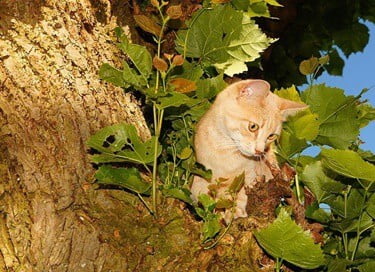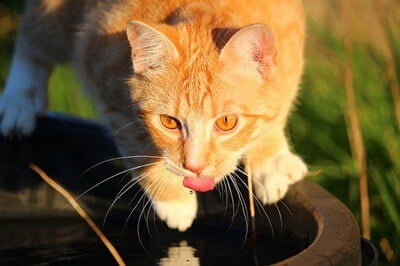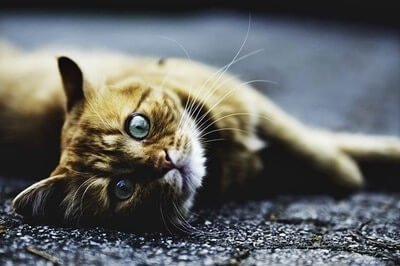It’s no secret that cats have some disgusting habits. Though they’re descendants of the African Wildcat, cats have evolved to become much-loved family pets and faithful companions. However, cats have retained unsanitary feral traits that don’t make much sense to their human owners.
Some cats offer dead prey to humans, while others will lick their privates in public. Cats are also known to eat their feces, drink urine, and spray around the house. If a cat has irritation around the anus area, it might scoot across the floor to get relief. Cats also enjoy eating earwax due to the high protein count.
While certain behaviors may seem disgusting to the human psyche, they make perfect sense in the feline world. If you’re curious about all the gross things cats do, read on to find out more about why they happen.
Why Are Cats So Disgusting?
What’s disgusting to us isn’t in the least bit repulsive to cats. However, cats do many things that are off-putting for humans. Remember that irritations, illnesses, and diseases can cause many cats’ strange behaviors. If a cat is acting oddly, there are likely to be underlying health conditions at play.
Other strange traits might be merely behavioral. A cat that’s not getting enough stimulation or is intrigued by its surroundings will do certain things that might confuse its owners.
Eat Earwax
Cats are drawn to earwax. Whether it’s through cleaning another cat’s ears or licking the earbud you’ve just used to clean your own, some cats just can’t help themselves.
Cats have 200 million scent receptors in their nasal cavity. To put this into context, a human has 5 million. Earwax contains dead skin cells, fatty acids, and small amounts of cholesterol. Using their excellent sense of smell, cats can determine that because earwax is mostly proteins and has nutritional value.
Cats only have a few hundred taste buds, so earwax doesn’t taste as bad to cats as it does to humans, who have over 10,000 taste buds. Arguably, earwax is beneficial to a cat’s health as it provides a good amount of nutrients. While you may not want to make earwax a staple part of your cat’s diet, it won’t hurt your feline to sample it from time to time.
Scoot Their Bums Across The Floor
A cat dragging its bum along the floor can be an amusing sight. But it’s actually a sign of irritation, itchiness, or pain around the anus area. Cats will find any means of relief, and often the rough textured surface of a carpet or rug provides ample respite from the problem. It is trying to relieve itself. Other causes of scooting include:
- Worms, which is a common cause of itchiness
- Items stuck to their bottom, including litter or dried poo
- Anal gland issues, including blockage or infection
- Itchy skin or other skin conditions
- A painful lump or another type of growth, such as skin tags
If you notice your cat scooting more often, look underneath its tail for any visible signs of discomfort. Check for dried feces or things that could be causing irritation. Redness, discharge, or indications of dry skin are also vital signs that something is irritating your cat’s anus area and may need further veterinary treatment.
Drink from The Toilet
It’s surprisingly common for a cat to drink from the toilet. For most humans, this is questionable behavior due to the traces of feces and urine, not to mention chemicals, such as bleach. Though, the reason why cats drinking toilet water is not as disgusting as you might think.
Cats are drawn to the colder water in the bowl, which is likely to be tastier than room temperature water that’s been sat in a dish for hours or even days. The water in the toilet bowl may also taste fresher, as regular flushing keeps it regulated and oxygenized.
Some cats might enjoy watching the water swirl around in the bowl each time the toilet’s flushed. Therefore, the flushing process may pique the interest of a curious cat, who will then go on to drink the water and splash about in the toilet bowl with its paw.
Eat You If You Die
According to National Centre for Biotechnology Information, scientists found that owners are at risk of being eaten by their hungry cats when they die after discovering that two feral cats broke into their research center to consume deceased bodies. Over several weeks, the cats kept returning to the bodies, showing a preference for the soft tissue of the shoulder and arm.
If a person with cats unexpectedly dies, the animals need to find a food source to survive. However, this only really applies if the deceased dies undetected for an extended period. Scavenging is also far more common in free-roaming cats. Tame cats aren’t likely to eat human flesh until they begin to starve.
Some scientists have theorized that cats may cause injuries to dead bodies by eating them and attempting to get attention or revive their owners.

Bring You Dead Animals
As instinctual hunters, cats often kill birds, mice, and other small prey animals. As reported in Nature, cats allowed to roam outside kill around 1 to 4 million birds and 6 to 22 billion small mammals each year in the U.S. alone.
But cats don’t always kill their prey to eat. Instead, they bring their catch home to their owners, whether dead or alive. Not only is this distressing, especially if the animal is showing signs of life or is left in a bloody state, but it’s also unhygienic. The owners are left to dispose of the bodies or remove wild animals that are still alive from the house.
Sniff Each Other’s Bums
Cats don’t see very well up close and don’t recognize other felines by appearance. They have peripheral vision designed to track prey, so their sense of smell lets them ascertain who’s close by. This is why cats sniff each other’s bottoms. It is a form of greeting and how they distinguish between cats.
Cats have anal sacs located on either side of their anus. As detailed in the US National Library of Medicine, these anal sacs secrete volatile compounds that function as chemical signals. Tests show that cats utilize short-chain-free fatty acids emitted from anal sax secretions to obtain scent information about individual cats.
Show Their Bums
Cats predominantly use body language to communicate. While cats also meow at humans to get their attention, body language is a good indication of how your cat is feeling. As mentioned, it’s also normal for a cat to sniff each other’s butts as a form of recognition.
When a cat shows you its bottom, don’t be grossed out – it is just hugging you in its unique way. It is also letting you know that it trusts you. Cats that feel threatened or are in no mood for affection will keep their tails down.
Cats are territorial by nature, so their ‘butt scent’ is a way for them to place their scent on you to lay claim to what is theirs. By petting a cat, you are doing the same thing.
Lick Their Privates in Public
Cats have many embarrassing behaviors but licking their private parts in public is among the worst. To humans, the concept is highly unpleasant. But to cats, it’s a simple grooming procedure that removes dirt, discharge, and debris. It’s common after a cat has urinated or defecated as the cat will feel the need to clean up.
However, this behavior could also be an indication that something is wrong. If a cat displays the following symptoms, it might be licking its private parts due to a health issue:
- A red or swollen vulva or penis
- Increased urination
- Difficulty urinating
- Scooting across the ground
- Red bumps on the skin
- Skin discoloration
- Foul odor from the affected area
- Discharge from the penis or vulva
Eat Their Own Feces
Coprophagia is the scientific term for eating poo. While it’s not that common in cats, some will consume their feces. There are many reasons why cats will do this. Health reasons can be to blame, such as vitamin or mineral deficiencies, malnutrition, parasites, diabetes, or thyroid disease.
Other reasons are often due to behavioral problems. Cats that have been recently punished, demanded attention, or are hiding a mistake, might eat their poop due to one of these processes.
A cat that eats its excrement is not displaying normal behavior. Therefore, treatment or intervention is required to stop it. Actions might involve moving the cat’s litter tray to a quieter area, cleaning up the litter tray as soon as the cat defecates, or changing its diet. Worming might also be needed if roundworms or tapeworms are behind the issue.
Drink Their Own Urine
It might sound bizarre, but cats will drink their pee. Though, this isn’t for fun. Cats will drink their urine if severely dehydrated and can’t find an appropriate water source.
Provide clean and fresh water daily, especially during warm weather periods. If the problem persists, even if the cat has access to water, there might be a health problem that requires treatment. Issues could include urinary tract disease, bladder inflammation, ruptured bladder, tumors, and kidney disease.
Urine drinking can also be a sign of a behavioral issue. Cats who have had a troubled past may have developed this habit to cope with their surroundings. Cats that don’t have access to the outdoors might even become bored, leading them to drink their pee.
Walk Through Their Litter Tray
Once a cat has been to the toilet in its tray, it will hide the urine and feces by covering it with litter. As reported in Live Science, this is a natural feline instinct to mask the scent as cats like to keep themselves clean. It also stems from their time in the wild, when they hid their waste to avoid their presence being detected.
Cats that bury their feces or urine do this to show their human owners that they recognize them as the ‘alpha’ of the house. The problem is, cats are likely to step in their waste and then walk it around the house.
Spray Around the House
A cat that has urinated in the house creates a mess that’s hard to clean up. The ammonia found in cats’ urine is particularly strong-smelling and can linger for months, even after a deep clean.
Illness, a sudden fright, or being trapped in a room can cause a one-off accident. However, spraying is different from urinating as it’s usually a signal used to mark the cat’s territory. To spray, a cat will stand upright and deposit a small amount of urine onto a vertical surface, usually on the wall or curtains.
There are several reasons why a cat might do this, including old age, urinary tract infections, or a fear of something either inside or outside the house.
Eat Their Vomit
Vomit is unpleasant, so it’s understandable that the owner will want to know why when a cat eats it. Random vomiting is quite frequent in cats. Many cats throw up hairballs or other foreign objects to remove them from the stomach. However, unlike the well-known myth, it’s not healthy for a cat to vomit regularly.
The truth is, no one really knows why a cat eats its vomit. Many experts believe it to be behavioral. Some cats might like the taste, while others might want to clean the mess up. A cat might even hide its sick from predators or other threats so that it can’t be found.
It’s more important to understand why a cat is vomiting in the first place. Prevention and treatment can help stop a cat from eating vomit. The most common reasons include:
- Hairballs
- Kidney or liver failure
- Gallstones
- Infections
- Poor diet
- Foreign bodies
- Gallbladder inflammation
- Allergies
- Constipation
- Tumors
- Parasites
Sweat from Their Paws
A cat’s paws are like baked beans. While cute, you’re likely to get a nasty scratch if you try to go near them. But did you know cats sweat from their paws?
Unlike humans, who have numerous sweat glands to cool themselves down, cats only have these glands in their paws, lips, chin, and skin surrounding the anus. These sweat glands work as an efficient cooling system and secrete a smell that cats use to mark territory. This means that cats often walk their sweat through the house.
When a cat’s body temperature gets too high, the brain sends a signal to these glands to start sweating. The sweat will then evaporate, cooling the body down. You’re most likely to notice wet paw prints on a hot day or the examination table during a stressful visit to the vets. Cats will also sweat through their paws if they feel anxious or threatened by something.

Drink from A Human’s Glass
Cats love fresh water that is off the ground. A nice, tall glass of clean water is tempting for cats, and they’ll have no reservations about drinking from it. This isn’t a pleasant concept for humans, especially when considering that cats lick their private parts after going to the toilet.
The biggest draw for cats when they spot a glass of water is the freshness. Cat’s don’t drink much water anyway, but they will turn their noses up at stale, lukewarm water if they can find a fresher option elsewhere. They might also feel safe if they’ve seen their owner using the same glass.
Posture might contribute to why a cat enjoys drinking from a glass, as it might be easier to access the water. Cats are also particular about how they position themselves when they eat or drink. Cats also copy their owners.
Poop Every Time You Eat
Whether it’s coincidental timing or carefully thought out, cats always seem to time their bowel movements to coincide with dinnertime. This is enough to put anyone off their food.
Needy cats will do this because they have stopped receiving attention while their owners eat. Humans will be more sensitive to the smell if the litter tray is too close to the dining area. The cat then gets the attention it craves.
Mother Cats Eat Their Placenta
Placentophagy, also known as placentophagia, is when mammals eat the placenta after giving birth. A scientific study on the US National Library of Medicine confirms that cats often eat the placenta. They do so to hide the evidence of birth and protect kittens from predators. As house cats rarely have predatory threats, this is mostly instinctual.
Eating the placenta is also part of the cleaning-up process. Once a kitten is born, the mother cat will break through the amniotic sac, chew through the cord, and lick the kitten to remove the blood and other birthing matter. This process also encourages the kitten to breathe.
So, while it might be uncomfortable watching a mother cat eat its placenta, it’s done so for the kitten’s health and wellbeing. There are also arguments for the nutritional benefit of the placenta, which offers an ample source of energy and food for milk production. This is vital, considering mother cats often don’t leave the nest for over 24 hours after giving birth.


Poop Every Time You Eat
Whether it’s coincidental timing or carefully thought out, cats always seem to time their bowel movements to coincide with dinnertime. This is enough to put anyone off their food.
Needy cats will do this because they have stopped receiving attention while their owners eat. Humans will be more sensitive to the smell if the litter tray is too close to the dining area. The cat then gets the attention it craves. The bes